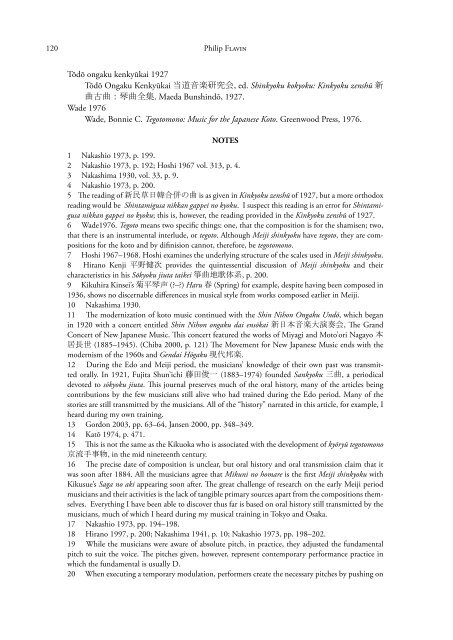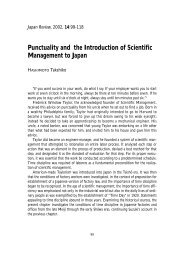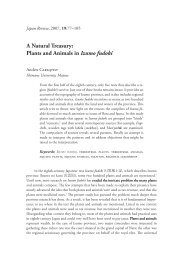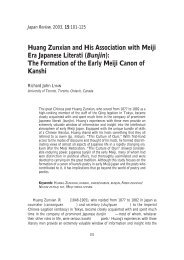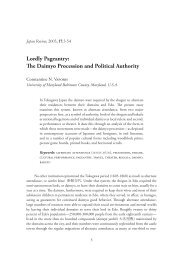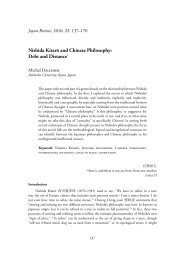Meiji shinkyoku - 国際日本文化研究センター
Meiji shinkyoku - 国際日本文化研究センター
Meiji shinkyoku - 国際日本文化研究センター
Create successful ePaper yourself
Turn your PDF publications into a flip-book with our unique Google optimized e-Paper software.
120 Philip Flavin<br />
Tōdō ongaku kenkyūkai 1927<br />
Tōdō Ongaku Kenkyūkai 当道音楽研究会, ed. Shinkyoku kokyoku: Kinkyoku zenshū 新<br />
曲古曲:琴曲全集. Maeda Bunshindō, 1927.<br />
Wade 1976<br />
Wade, Bonnie C. Tegotomono: Music for the Japanese Koto. Greenwood Press, 1976.<br />
NOTES<br />
1 Nakashio 1973, p. 199.<br />
2 Nakashio 1973, p. 192; Hoshi 1967 vol. 313, p. 4.<br />
3 Nakashima 1930, vol. 33, p. 9.<br />
4 Nakashio 1973, p. 200.<br />
5 Th e reading of 新民草日韓合併の曲 is as given in Kinkyoku zenshū of 1927, but a more orthodox<br />
reading would be Shintamigusa nikkan gappei no kyoku. I suspect this reading is an error for Shintamigusa<br />
nikkan gappei no kyoku; this is, however, the reading provided in the Kinkyoku zenshū of 1927.<br />
6 Wade1976. Tegoto means two specifi c things: one, that the composition is for the shamisen; two,<br />
that there is an instrumental interlude, or tegoto. Although <strong>Meiji</strong> <strong>shinkyoku</strong> have tegoto, they are compositions<br />
for the koto and by difi nision cannot, therefore, be tegotomono.<br />
7 Hoshi 1967–1968. Hoshi examines the underlying structure of the scales used in <strong>Meiji</strong> <strong>shinkyoku</strong>.<br />
8 Hirano Kenji 平野健次 provides the quintessential discussion of <strong>Meiji</strong> <strong>shinkyoku</strong> and their<br />
characteristics in his Sōkyoku jiuta taikei 箏曲地歌体系, p. 200.<br />
9 Kikuhira Kinsei’s 菊平琴声 (?–?) Haru 春 (Spring) for example, despite having been composed in<br />
1936, shows no discernable diff erences in musical style from works composed earlier in <strong>Meiji</strong>.<br />
10 Nakashima 1930.<br />
11 Th e modernization of koto music continued with the Shin Nihon Ongaku Undō, which began<br />
in 1920 with a concert entitled Shin Nihon ongaku dai ensōkai 新日本音楽大演奏会, Th e Grand<br />
Concert of New Japanese Music. Th is concert featured the works of Miyagi and Moto’ori Nagayo 本<br />
居長世 (1885–1945). (Chiba 2000, p. 121) Th e Movement for New Japanese Music ends with the<br />
modernism of the 1960s and Gendai Hōgaku 現代邦楽.<br />
12 During the Edo and <strong>Meiji</strong> period, the musicians’ knowledge of their own past was transmitted<br />
orally. In 1921, Fujita Shun’ichi 藤田俊一 (1883–1974) founded Sankyoku 三曲, a periodical<br />
devoted to sōkyoku jiuta. Th is journal preserves much of the oral history, many of the articles being<br />
contributions by the few musicians still alive who had trained during the Edo period. Many of the<br />
stories are still transmitted by the musicians. All of the “history” narrated in this article, for example, I<br />
heard during my own training.<br />
13 Gordon 2003, pp. 63–64, Jansen 2000, pp. 348–349.<br />
14 Katō 1974, p. 471.<br />
15 Th is is not the same as the Kikuoka who is associated with the development of kyōryū tegotomono<br />
京流手事物, in the mid nineteenth century.<br />
16 Th e precise date of composition is unclear, but oral history and oral transmission claim that it<br />
was soon after 1884. All the musicians agree that Mikuni no homare is the fi rst <strong>Meiji</strong> <strong>shinkyoku</strong> with<br />
Kikusue’s Saga no aki appearing soon after. Th e great challenge of research on the early <strong>Meiji</strong> period<br />
musicians and their activities is the lack of tangible primary sources apart from the compositions themselves.<br />
Everything I have been able to discover thus far is based on oral history still transmitted by the<br />
musicians, much of which I heard during my musical training in Tokyo and Osaka.<br />
17 Nakashio 1973, pp. 194–198.<br />
18 Hirano 1997, p. 200; Nakashima 1941, p. 10; Nakashio 1973, pp. 198–202.<br />
19 While the musicians were aware of absolute pitch, in practice, they adjusted the fundamental<br />
pitch to suit the voice. Th e pitches given, however, represent contemporary performance practice in<br />
which the fundamental is usually D.<br />
20 When executing a temporary modulation, performers create the necessary pitches by pushing on


